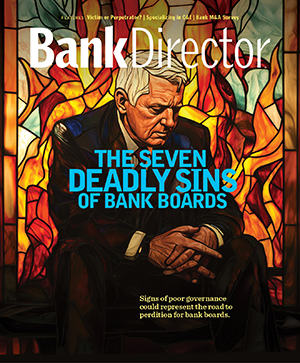
Strangers in a Strange Land
As digital expectations continue to rise among consumers, many traditional banks must feel as if they’ve suddenly found themselves in an alien world.
Chief executive officers and directors representing a diverse range of U.S. banks express significant doubts about their ability to serve digitally-savvy millennial customers who should be the source of the industry’s future growth opportunities, according to Bank Director’s 2015 Growth Strategy Survey. Indeed, traditional banks find themselves in a dramatically altered marketplace where consumers can, in essence, put their bank in their pocket instead of traveling to a local branch.
Eighty-two percent of bank executives and board members also expect organic loan originations to fuel growth within the next 12 months. Less than one-quarter cite loan demand as a primary concern related to the growth and profitability of their bank. Eighty-eight percent indicate loan volume was the primary driver of profitability over the past year, and just 21 percent say that constraints on loan growth had a negative impact on their bank. The lending outlook appears more or less rosy for 2016.
The survey was sponsored by Vernon Hills, Illinois-based technology firm CDW and received 168 responses from bank CEOs, independent directors, chairmen and other senior bank executives from May through July of this year. The survey reveals how these bank leaders expect to grow their institutions, and the contributors and barriers to their profitability. It also examines how technology is being deployed within the industry, and how boards are overseeing its ongoing evolution.
When survey respondents are asked about where, exactly, they see opportunities in the marketplace, concerns about the return of old, pre-crisis habits emerge. Eighty-five percent of respondents expect to grow through commercial real estate loans, up eight percentage points from last year’s survey. Fifty-six percent see opportunities in commercial & industrial (C&I) lending. Respondents see more opportunities in construction loans, up by 11 points in the past year, to 39 percent of respondents. Doesn’t this sound like déju00e0 vu? A high dependence on the real estate market brought down many banks just a few short years ago.
“I feel like we’re going back to old habits,” says Scott Hiemstra, financial services sales manager at CDW. A high dependence on real estate lending not only exposes the bank to more risk, but Hiemstra worries that overly focused bank leaders might not keep their eyes peeled for new opportunities. “But right now that’s where they’re growing, and that’s what they’re sticking to,” he says.
Respondents that see opportunities in residential mortgages rose 14 points in the past year, to 45 percent, reflecting a steady improvement in home sales. In May of this year, the National Association of Realtors announced that pending home sales reached the highest level seen in nine years. Home prices have also been rising steadily in 2015, according to the Federal Reserve Bank of St. Louis.
Few respondents, just 13 percent, see opportunities in consumer lending. This apparent lack of interest in the consumer loan market could explain why just 35 percent worry about the threat of peer-to-peer (P2P) lenders, like Lending Club and Prosper Marketplace.
Lending Club offers personal loans up to $35,000, and business loans up to $300,000. Loans from Prosper range from $2,000 to $35,000. The companies, both based in San Francisco, connect borrowers directly to investors, who receive monthly payments as borrowers repay the loan. While both companies have grown quickly, together they still account for only a fraction of the total loans originated by traditional banks. Banks and thrifts generated $8.4 trillion in loans in the first quarter 2015, according to the Federal Deposit Insurance Corp. (FDIC).
So banks shouldn’t worry about competition from online lenders, right? Yes and no, says Pete Kight, a board member and chairman of the technology committee at $69 billion asset Huntington Bancshares, headquartered in Columbus, Ohio. He believes that online lenders may find a more difficult environment once interest rates finally rise and capital is harder to obtain, but says that banks can learn a thing or two from these fintech upstarts. “Banks can win in this space, because the bank brand and historical stability still stand for something,” he says. “But banks will need help on the digital side, because it is moving too fast for even the most advanced banks to keep up.”
Lending Club partners with some banks, helping these institutions to further diversify their portfolios by identifying loans based on the bank’s credit policy and risk guidelines. Few respondents-just 1 percent-currently partner with P2P lenders. An additional 6 percent believe that partnering with these companies could be an opportunity for their bank. Most respondents, at 53 percent, don’t have an opinion on whether P2P lenders are a threat, an opportunity, or a little bit of both.
Chris Martin, president and CEO of $8.8 billion asset, Jersey City, New Jersey-based Provident Financial Services Inc., says fintech firms, including P2P lenders, are on his radar, but he doesn’t see these lenders as a direct threat to his bank’s business. Lending Club and Prosper cater to clients that are small potatoes compared to the loans that Provident and many other traditional banks offer. “None of our commercial clients have been approached to do a $10 million loan on a peer-to-peer basis,” he says.
The survey reveals some ambivalence about branch banking trends, despite several years of doom-and-gloom pronouncements calling for the death of the branch. Branches might not be frequented as they once were, but they’re hardly being abandoned either. Eighty-two percent of consumers surveyed by the Federal Reserve in December 2013 had visited their local branch at least once within the last year. Bank Director’s survey finds that 43 percent of respondents indicate their bank plans to make no changes to the number of branches in their network in 2015. Twenty-three percent plan to scale back on the number of branches.
Thirty-one percent actually plan to expand their branch network in 2015, and almost one-quarter expect de novo branches to contribute to growth over the next 12 months. Bucking the trend set by other big banks such as Bank of America Corp. and JPMorgan Chase & Co. to cull branches, Toronto-Dominion Bank, based in Toronto, Canada, opened more branches than it closed in the one-year period ending April 2015. The company also claims that its branches stay open longer than those of its Canadian competition.
Daniel Walker, chief executive officer of Farmers & Merchants Bank of Long Beach, a $5.7 billion asset bank based on Long Beach, California, says some of the bank’s strongest growth has come through de novo expansion. When big banks such as Bank of America consolidate branches in his area, he sees an opportunity for Farmers & Merchants to win over consumers that now have to travel farther to visit their bank. “That’s really a drop in the bucket for [big banks],” says Walker, but it “gives me a great opportunity to continue to expand in those successful market areas.” Farmers & Merchants currently has 23 branches in Long Beach and Orange County.
Seventy-seven percent of respondents plan to increase their investment in technology within their branches, in line with industry trends toward self-service for bank customers. Almost half of respondents indicate their bank uses digital messaging or advertising within their branches. “It seems as if they all have flat screens now,” says Hiemstra. These screens communicate messages and advertise to customers in the branch. Forty-three percent use cash recyclers, which automates the process of accepting and dispensing cash to customers.
Video tellers remain less common, used by just 10 percent of respondents. Hiemstra says video tellers can allow banks to reduce the number of tellers in the branch-as 43 percent of respondents indicate they plan to do this year-but adds that these efficiencies come at a cost. “That creates a major shift in business in the banking world. When you move to video tellers, it enables the bank to create call centers,” says Hiemstra. These tellers need to be more knowledgeable and versatile than traditional tellers, and that requires additional training by the bank.
Bank executives and boards are slowly adapting to technological changes throughout the industry. Technology is a more frequent item today on board agendas: Forty-five percent say they discuss technology at every board meeting, up from 30 percent in last year’s survey. Thirty-four percent indicate their board has a technology committee, and almost half say their board has at least one director with a technology background. This increased focus may be driven by fear, says Hiemstra: Seventy-nine percent of respondents say that protecting the bank against cyberattacks is one of their top technology concerns.
First Niagara Financial Group, headquartered in Buffalo, New York, with $39 billion in assets, established a board-level technology committee in 2014. The committee helps the board oversee the company’s investment in technology, and ensures the bank is competitive with its peers. Sue Harnett joined First Niagara’s board earlier this year, and serves on the bank’s audit and compensation committees. “Technology is an enabler. How you use it determines the business result,” she says. “Myself, and the other board members, are very much focused on ensuring that we achieve the business results that are desired with the new technology.”
Two-thirds of respondents indicate they’re concerned about the bank’s ability to spend the right money on the right technology. As the pace of financial innovation increases, bank boards need to know how to invest their technology dollars in the most effective way.
“The technology is coming so fast. The adoption rate, by the time you adopt it, [then] it’s something else that’s coming out,” says Martin. “We look at it very carefully.” Among these considerations is how the bank will use the technology, and how long they expect it to satisfy customers.
“You don’t want to wait five years before you get new technology,” Harnett says, based on her experience in retail banking at Citigroup and e-commerce at the Dutch bank ABN AMRO. “It’s more of a path of continuous improvement that is desired.”
Mobile banking has become almost as ubiquitous as branch banking: Ninety-two percent of respondents indicate their bank offers mobile, compared to 87 percent in last year’s survey. But 40 percent are concerned that their bank’s mobile offering isn’t keeping pace with consumer demands.
The lack of progress among many banks when it comes to mobile could be tied to the fact that bank boards don’t truly understand it. Seventy percent of the directors responding to the survey indicate they don’t use their own bank’s mobile channel. CEOs are better users of their bank’s technology: Seventy percent use both online and mobile banking.
Farmers & Merchants’ Walker believes it’s important for both bank employees and board members to use the technology offered by the bank. “I use every area I can with the bank on technology,” he says.
More than 80 percent of respondents indicate that their bank offers bill pay, remote deposit capture (RDC), and account history within the mobile channel, and 69 percent allow customers to check their balance. Twenty-seven percent of respondents see the potential for growth in fee income in mobile banking, and those that appear to have had success in it, such as Minneapolis-based U.S. Bancorp and Regions Financial Corp., headquartered in Birmingham, Alabama, embed tiered fees within RDC. U.S. Bancorp charges $0.50 for each deposited check. Customers at Regions pay more if they need faster access to funds, starting at a base of $0.50 per check to as much as 3 percent of the check’s value for immediate availability.
Andy Hernandez, executive vice president and head of eBusiness for Regions, says the bank’s mobile banking revenue is on a steady growth curve. “Over the past 12 months, we have seen a 13 percent increase in mobile deposit adoption,” he said in an emailed statement. “Revenue earned allows us to continue enhancing our mobile banking offerings to meet customer needs.” Regions declined to provide specific data on mobile banking’s contribution to the bank’s overall fee income. U.S. Bancorp did not comment for this story.
Some of the features that many banks don’t offer are the types of services in which nonbank competitors excel. Just 28 percent indicate their bank offers P2P payments within their mobile channel, but social media giant Facebook offers this service through its Facebook Messenger app. The service does rely on traditional banks: Users link their debit card to send money from one checking account to another. Payment companies Square and PayPal also offer P2P payments.
Just 9 percent of respondents say their bank offers discounts and deals with merchants, a service that can increase customer engagement. Bank of America’s BankAmeriDeals and Discover Deals, by Discover Financial Services, are two examples of financial companies connecting their customers to savings with retailers.
Thirty-seven percent of respondents indicate that their bank offers personal financial management (PFM) tools, through online or mobile banking. PFM has been successful for companies such as Simple, which in early 2014 was acquired by the Spanish banking giant BBVA, and Moven, which functions as an online bank. Moven provides users with a spending gauge, which lets them categorize expenditures as “wants,” like going out to dinner or traveling; “needs,” like groceries; and savings. In December 2014, Toronto-Dominion Bank announced a partnership with Moven to use Moven’s technology to offer PFM to the bank’s Canadian customers.
Provident started offering PFM on its website in June. Provident offers financial management within its branches, but Martin says this helps some customers avoid the hassle of scheduling time with an adviser. “We really think of it as the future, because people want to self-serve,” he says. He believes PFM will help the bank expand current relationships and attract new clients to the bank’s wealth management products. Banks are seeing more opportunities in trust and investment management. Fifty-five percent of respondents see opportunities for growth in fee income in that area, an increase of 25 percent since last year’s survey.
It’s that question, again, of where to more quickly invest in technology, and where to adopt a wait-and-see approach. Just 18 percent of survey participants say their bank offers Apple Pay; the service is more common at banks above $10 billion in assets. Of those that don’t, 63 percent say their bank just isn’t ready to partner with the service. Nineteen percent don’t believe it will have a positive impact on their bank’s profitability. This probably goes a bit further in explaining why most banks are dragging their heels: Mobile payments aren’t seen as a profit driver by many community banks. “If it drives profitability, I think that it would actually be used more often,” says Hiemstra.
These questions of how to meet consumer demands with the right technology will only multiply. Many digital natives-the millennials-have reached adulthood and need financial services. However, 60 percent of respondents say their bank might not have the right products and services to meet the needs of this generation, the oldest of whom are now in their mid-30s.
Thirty-two percent of millennial consumers are already using or very likely to use mobile payments, such as Apple Pay-twice as likely as adults aged 35 years or older, according to a survey of U.S. bank customers conducted in August 2014 by FICO. The same study says that 23 percent of millennials feel the same about P2P lenders.
“We are not doing enough to secure the millennials,” says Walker. He says that’s something his bank plans to change very soon by bringing in focus groups and establishing a plan. The bank aims “to give them reasons to bank with Farmers & Merchants that other institutions don’t provide.” (For more on how some banks are addressing the needs of millennials, read “Invasion of the Millennials” on page 28.)
Meeting the technology needs of the bank and its customers now requires more than just the bank’s information technology department, which can no longer be the sole provider of answers on what has become an increasingly complex and diverse issue. “They can’t solve these problems any longer,” says CDW’s Hiemstra. Personnel representing various areas of the bank need to come together to determine the bank’s technology needs.
Bank boards can’t afford to stand idly by on these decisions. And if the board has a diverse skill set, there’s a lot that directors can contribute-if they approach technology in a proactive way.
About the Survey
In May, June and July, Bank Director surveyed 168 senior executives and board members of U.S. banks about growth, profitability and technology trends. The survey was conducted both online and through the mail. Independent directors and chairmen account for 49 percent of respondents, and 45 percent are CEOs. More than half of the respondents represent financial institutions with more than $1 billion in assets. The complete results of the survey are available in the research section at BankDirector.com.
Questions About Our Research?
Contact Emily McCormick, at [email protected], if you’d like to know more about Bank Director’s research initiatives.

Join OUr Community
Bank Director’s annual Bank Services Membership Program combines Bank Director’s extensive online library of director training materials, conferences, our quarterly publication, and access to FinXTech Connect.
Become a Member
Our commitment to those leaders who believe a strong board makes a strong bank never wavers.



